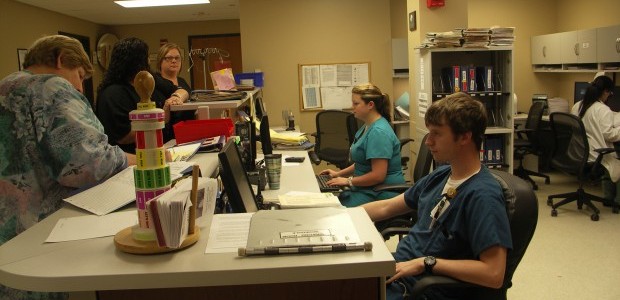
Chabert hit with added cuts and job losses
October 5, 2012
Chamber’s BOB fest draws fire for divisiveness
October 9, 2012Patients are upset, employees are worried and regional legislators contend the fight is not over yet. Strong reactions followed Thursday’s announcement that Leonard J. Chabert Medical Center had been ordered to cut 245 jobs (of which 25 are already empty) and reduce its budget another $14.3 million by Jan. 1, 2013.
This is the third financial blow delivered to the state’s so-called charity hospitals by the LSU Health Care System Board of Supervisors during 2012. In total, a 34.5 percent budget reduction means a newly required cut of $287.1 million in budgeted state general funds and a loss of 1,495 jobs in less than three months. Financial cuts also reflect a reduction of $329.2 million in federal funds.
“It is pretty shocking and upsetting to our staff and patients,” Leonard J. Chabert Medical Center CEO Rhonda Green said. “I am working with other agencies trying to mitigate some of this.”
“In every instance, we have worked to maintain the most critical patient clinical services, especially our medical homes, and support graduate medical education,” LSU Health Care System President William Jenkins said in an emailed statement.
Home Impact
At its core, the Houma-based medical center has been known as a premier location for training doctors with three independent programs through LSU, Ochsner and by the hospital itself. With new budget cuts, both the LSU and Ochsner programs would be transferred to other facilities while Chabert’s are completely eliminated. Estimated financial savings to the state is listed at $1.7 million.
“I would not have residents at all,” Green said. “Residents see 75 percent of our outpatient volume. So, access to care will be reduced by 75 percent.”
Green called Chabert’s residency program this hospital’s foundation for the past 34 years.
Chabert has for most of its existence generated a profit. However its current $93.2 million budget and staff of 840 employees could witness obvious differences, starting with a 50 percent reduction of all physicians by the end of 2012.
Three of the hospital’s six operating rooms are listed to be closed. The dental clinic is to be reduced by 30 percent, while both inpatients and emergency room services are each slashed in half.
Complete department closures are designated for dermatology, neurology, ophthalmology, orthopedic services, outpatient lab and pharmacy, physical therapy, research and women’s health.
“Well, we would still have an emergency department,” Green said. “With it reduced by half, it will make wait times go up. We will have limited inpatient beds so that will impact the amount of surgeries we can do. Patients will have to wait and some services they will not be able to receive at all here. It makes it very difficult because the closest state hospital in proximity is in New Orleans and [the LSU Public Hospital] is also cutting services.”
Patients and Professionals
Ipiana Pedrozo is 90-years-old. As a Medicare patient she was upset to hear of the cuts while resting in her hospital bed. “I like the people here very much,” Pedrozo said of the staff caring for her. “It is going to be hard to pay the bill.”
‘[These cuts] mean a lot,” Cheryl Pond said. “If I were not here where would I be? I was diagnosed with breast cancer and I have no income and no insurance. So if I didn’t have this hospital to come to where would I be?”
Charlotte Daigle is a post-op and pediatrics nurse. She has had to train new staffs twice in nine months as previous cuts eliminated personnel in her department. “This will be the third time in less than a year,” she said. “I have people already looking for other jobs.”
Daigle said there is a great deal of uncertainty among hospital employees and by constantly bringing in new people, patient care is impacted. “It’s devastating,” she said.
Medical unit and telemetry nurse Mykah Boudreaux has only been in the profession 21 months and is among Chabert employees that insist this facility is a special place. “Hopefully, nothing is definite yet,” she said. “We are trying to get everything verified. They tell us not to believe everything we read. It is scary.”
By contrast, Carolyn Schmolke is a 25-year Chabert employee who has weathered storms of planned cuts in the past. This time, however, she admitted it seems different. “They haven’t shut us down yet,” she said, “but there is no telling what is happening now that they are taking all our money away.”
Economic Impact
Administrators and staff at Chabert are not the only ones worried about what affect a 14.3 percent economic cut and significant loss in jobs and services will mean for the region.
“When you curtail operations at Chabert, the indigent care will go to Thibodaux Regional and Terrebonne [General Medical Center],” state Rep. Joe Harrison said regarding a chain reaction of need with services unable to meet demand. “Do you have any idea how much of that is going to impact their bottom line and put them into financial straights?”
Terrebonne General Medical Center CEO Phyllis Peoples admitted that additional patient load, particularly in emergency room services, would be a strain on the region’s largest health care facility. She also said TGMC will do what it can to meet public need.
“Terrebonne General only has limited resources, too,” Peoples said. “We will figure out what is right. We will partner and find whatever [assistance] we can. We will ask the community for additional support and resources while we work through it.”
“[Cuts to Chabert] will certainly have an impact,” Terrebonne Economic Development Authority CEO Steve Vassallo said. “As far as the dollars, we would have to look at where the cuts are going and the ripple effect of that to the larger economy.”
“It is a challenge, but it is something that we as an administration can look at to see what we can do to continue to provide services,” Chabert Director of Ancillary Services Dr. Ken Duet said. “The patient is the most important piece of this.”
“LSU Health has long been on an unsustainable path …,” LSU System Executive Vice President of Health Care and Medical Education Redesign Dr. Frank Opelka said in a printed statement. “Decreasing inpatient volumes and continued isolation from the evolving health care market have resulted in a system in decline.”
Opelka said the LSU system must be transformed to emphasize core competencies and cover critical services. He went on record as supporting public-private partnerships as an economic model for health care.
Legislative Language
No one was more passionate following the announced cuts than Tri-parish state legislators that have been working to secure operational independence for Chabert from the LSU Health Care System.
“I didn’t see an economic plan or a true study of the cuts,” state Rep. Joe Harrison (R-Napoleonville) said following a Joint Health and Welfare Committee meeting with the LSU Board of Supervisors late Thursday. “Nor did I see anyone put together a plan that was nothing more than across the board. There are only two hospitals in this system that drive revenue in the state and that is Chabert and Shreveport. For them to arbitrarily take money away from a revenue source is not good government and it certainly isn’t good business.”
“As it stands right now it is about as bad a situation for the hospital as it can get,” state Sen. Norby Chabert (R-Houma) said. “I am totally disgusted with the way [Gov. Bobby Jindal’s] administration has handled it.”
State Rep. Jerome “Dee” Richard (NP-Thibodaux) has spearheaded an attempt to call the Louisiana Legislature back into a 15-day special session. He said Friday that outrage with the LSU Health Care System Board of Supervisors might be the push his effort has needed.
“I think this will help get the numbers required to push for a special session,” Richard said. “I’m putting the call out. The legislature should know about these cuts and have input in it.”
In order to secure a special session, a petition circulated by Richard needs 53 members of the state House of Representatives and 20 state Senate members supporting it.
The call is one Harrison said is needed because dealing with health care in Louisiana was not properly formulated the first time.
“It is pitiful that we are in a situation that the people are not being part of the process,” Harrison said. “The decision that was made is a backroom kind of deal.
“It isn’t a hospital problem or a people problem,” he continued. “It is a budget problem. We should be going into meetings and we need to solve our budget problems and not throw away the basic needs of our people. I’m sick of this kind of politics. The people need to stand up and say, ‘Enough is enough.’”
Richard said getting the Legislature to act would be one thing, but constructing a plan the governor would sign is a challenge of its own.
Uncertain Outlook
When asked what kind of hospital Chabert would be after January 2013, Green was unable to offer a specific answer. “If this current plan goes through we would see a reduced version of what we have now,” she said.
“It sounds like they want to have it be just core medicine,” Boudreaux added. “ER and internal medicine. They want to do away with all the outside clinics.”
“I fear there will only be three [charity hospitals] in the state,” Harrison said. “They will be in Baton Rouge and New Orleans. We will revert back to what we had in the 1960s when the people of this region had to travel all the way to New Orleans.”
Leonard J. Chabert Medical Center addressed budget cuts from the LSU Health Care System Board of Supervisors in March when it was forced to eliminate $2.9 million, close its labor and delivery department and reduce its workforce by approximately 100 people. In July the hospital was hit with another order for cuts totaling more than $3.7 million.
Others Impacted
In addition to Chabert’s cuts, LSU system officials have instructed the Interim LSU Public Hospital in New Orleans to eliminate more than $49 million and slash 423 positions.
Earl K. Long Hospital in Baton Rouge has been told to cut more than $38 million and 341 jobs.
The University Medical Center in Lafayette is in line for a loss of $22 million and 173 positions.
Bogalusa Medical Center is being required to reduce its budget by more than $11 million and cut 146 positions, and Lallie A. Kemp Regional Medical Center in Independence is set to lose more than $22 million and 173 jobs.
Post-op employees at Leonard J. Chabert Medical Center continue their work knowing that by the end of this year their individual jobs may no longer exist. Several have said they have already begun looking for other opportunities even outside their chosen profession of health care. Pictured from left are Jody Rose, Christie Fanguy, Heather Champagne, Margo Guidry and Nick Griffin.













